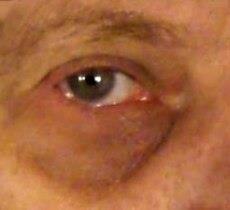


Joseph R. Anticaglia, MD
Medical Advisory Board
Mom took her four year old son Gregory to the pediatrician wanting to know what’s causing the dark circles under his eyes. Arlo, a 63 year farmer told his family doctor that the dark circles under his eyes have gotten worse over the last few years. “Is there anything I can do about it, Doc?”
Dark circles under your eyes means the area of skin below the eyes looks darkened. It is a common condition that affects people of all ages. People may look at your dark circles, and wonder, “Are you OK? Did you get enough sleep? Did something happen, you look sad? You look tired and worried.
There are many causes of dark circles, but most often it is a cosmetic issue and doesn’t pose a danger to your health. People are more prone to experience dark circles under the eyes if they have a family history of it, have a darker skin color, and/or are elderly..
Children with allergies can develop dark circles under the eyes due to nasal congestion as was the situation with Gregory. The blood vessels under the eyes do not drain properly, become swollen and the skin appears darker, (Allergic Shinners).
In Arlo’s case, his exposure to sunlight for many hours and for many years contributed to his complaint of dark circles under the eyes. In addition, as one ages the skin under the eyes becomes thin, and the vessels become more transparent casting a darker appearance to the skin under the eyes.

Dark circles under the eyes have many causes, which include allergies, sun exposure, and aging which were noted above. Sleep deprivation, and anemia can cause paleness of the skin, which make the blood vessels become more prominent and darkening the skin color under the eyes.
If your parents, or siblings have dark circles under the eyes, you have inherited them form your parents (genetics). Overactive or underactive thyroid conditions can cause dark circles under the eyes. Other causes include rubbing your eyes, eczema, contact dermatitis, smoking or drinking too much alcohol.
The majority of cases of dark circles under the eyes is a cosmetic problem. The goal of treatment is to lessen the appearance of dark circles..
Things You Can Do to impede the appearance of dark circles include lifestyle changes that we’ve heard about many times in the past, such as quit smoking; since it accelerates the aging process of the skin. Reduce alcohol consumption, since it can interfere with blood circulation. Reduce stress, and get a good night’s sleep. Use sunscreen particularly under your eyes. You can use a makeup concealer to lighten up dark circles. Use makeup that’s a shade lighter than your skin type.
Medically, your physician may prescribe a stronger dose of retinoids, which is in the vitamin A class of medications to be applied topically to the dark circles under the eyes. Laser therapy can be helpful, and injectable fillers can fill the hollows in the bone under the eyes that cause shadows and dark circles. At times, surgery for swollen lower eyelids can be helpful.
A chemical peel is recommended when dark circles under the eyes are the result of excess pigmentation/melanin in the skin. Peels work by exfoliating, (removing, peeling) the outer layer of dead skin.
Dark circles under the eyes are common complaints that affect people of all ages. They are often due to allergies, aging, lack of sleep and genetics. There are medical and non-medical options available to treat this condition. Talk with your doctor about the treatment options available to you.
Infraorbital dark circles, also known as periorbital hyperpigmentation, are cosmetic concerns that cause the lower eyelid skin to appear relatively dark.
Retinol is a form of vitamin A, a retinoid, which can be purchased over the counter and used topically to treat a variety of skin conditions.
Certain medications and medical conditions can give rise to dark circles under the eyes, and are treated accordingly.
This article is intended solely as a learning experience. Please consult your physician for diagnostic and treatment options.